A conversation with Caroline Sly, a western Massachusetts cabinetmaker and staunch preservationist.
“There are mullions, and then there are muntins; a mullion is a post that connects multiple window units, and muntin is the small piece that separates two or more panes of glass on a single window sash.” I was being educated by Caroline Sly, architectural joiner and cabinetmaker, about the nuances of window construction and two seemingly interchangeable, but oft misused terms.
Renowned as a maker of exact reproduction, hand-made 18th century window sash and frames for those seeking authenticity, Sly has been happily immersed in preserving the past for over three decades. Recently, she had welcomed me into her shop in Ashfield, MA, a journey that I was delighted to undertake, as Route 116 between there and Deerfield is one of the more sublime roads on which to drive a sports car in Western Massachusetts; the scenic winding curves and climbs are perfect for sharpening one’s shifting and cornering skills. (Note to the Conway Police: I was very respectful of the posted limits in the village.)
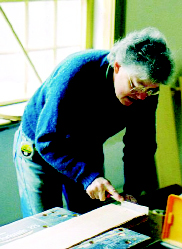 A native of Quincy, Massachusetts, Sly was exposed to the world of antiques by her mother and grandmother, and discovered that she wanted to restore and replicate the missing or damaged pieces she encountered. Enrolling in graduate school at Smith College in Northampton, she soon realized that western Massachusetts was to be her permanent home. Self-educated, Sly made pilgrimages to every antique house of note to study the construction of its woodwork and fenestration, and then sought to read every book on this subject. When asked if she had a mentor who guided her, she replies, “No, the houses taught me!” As with so many of us who have blazed our own paths, Caroline’s fascination for 17th and 18th century joinery and cabinetmaking has become a life-long passion.
A native of Quincy, Massachusetts, Sly was exposed to the world of antiques by her mother and grandmother, and discovered that she wanted to restore and replicate the missing or damaged pieces she encountered. Enrolling in graduate school at Smith College in Northampton, she soon realized that western Massachusetts was to be her permanent home. Self-educated, Sly made pilgrimages to every antique house of note to study the construction of its woodwork and fenestration, and then sought to read every book on this subject. When asked if she had a mentor who guided her, she replies, “No, the houses taught me!” As with so many of us who have blazed our own paths, Caroline’s fascination for 17th and 18th century joinery and cabinetmaking has become a life-long passion.
When it comes to restoring and repairing the original fabric of an old structure, Sly stresses that by restoring with the original methods of construction and material, you are not only saving the individual item, you are also preserving the craft as well by keeping the trade itself alive. Without defenders of the archaic skills such as Sly’s, those with 18th century homes would be condemned to utilizing mass-produced finger-jointed, new growth sapwood that will fail within a generation instead of centuries.
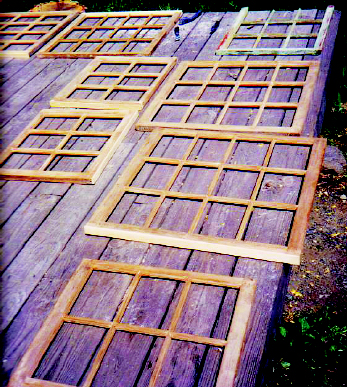 Those us who live in old houses often take their windows for granted (save for myself, whose 1917 vernacular Mission-meets-Monopoly house sports horrible white replacement windows from the 1970s). When touring Sly’s workshop, however, one develops a true appreciation for the intricacies and detailing of a 200 year old sash. Her material of choice is old-growth, quarter-sawn, clear pine, and it’s surprising how delicate each muntin and rail is of any piece of sash. Free of decades of over-painting, the crispness of the construction becomes evident and one is given a glimpse of the past, for the window and sash are identical to the ones that were created centuries earlier.
Those us who live in old houses often take their windows for granted (save for myself, whose 1917 vernacular Mission-meets-Monopoly house sports horrible white replacement windows from the 1970s). When touring Sly’s workshop, however, one develops a true appreciation for the intricacies and detailing of a 200 year old sash. Her material of choice is old-growth, quarter-sawn, clear pine, and it’s surprising how delicate each muntin and rail is of any piece of sash. Free of decades of over-painting, the crispness of the construction becomes evident and one is given a glimpse of the past, for the window and sash are identical to the ones that were created centuries earlier.
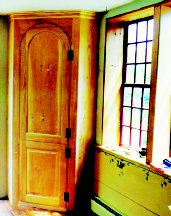 Caroline has collected antique hand planes over the years, and uses them to shape each part of a project by hand. She then cuts the mortises and tenons, and then pegs them together, after which she constructs the entire window unit with reproduction antique nails, so that when installed in an old structure, nothing belies its recent history. During my visit, she was finishing some frames for a New Hampshire house; each had a distinctive touch, for the lintel was cut into the vertical members with a small return that reinforced the framework. Sly believes these are indigenous to their region.
Caroline has collected antique hand planes over the years, and uses them to shape each part of a project by hand. She then cuts the mortises and tenons, and then pegs them together, after which she constructs the entire window unit with reproduction antique nails, so that when installed in an old structure, nothing belies its recent history. During my visit, she was finishing some frames for a New Hampshire house; each had a distinctive touch, for the lintel was cut into the vertical members with a small return that reinforced the framework. Sly believes these are indigenous to their region.
Recognizing the need for contemporary energy conservation, Caroline also makes interior storms and was displaying a cleverly designed exterior door with a plank inner construction and a 6-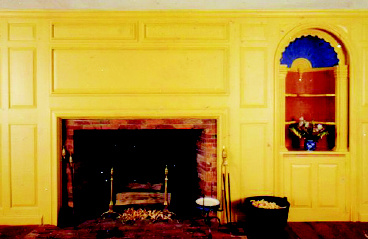 panel exterior that was invisibly sandwiched over insulation. While she mainly works with hand-tools, which yield the rich nuances of craftsmanship, she does not object to the use of power tools to roughly dimension the wood, as anyone who has ever tried to pit-saw a timber would immediately understand. Sly eschews the use of glue and insists that properly joined and pegged pieces never require its use: they will maintain their structural integrity, while remaining flexible to changes in temperature and humidity over the decades. Sly also makes and restores hand-made doors: she points to a four panel door in mid-restoration, an instance where someone had removed the top two panels and inserted glass, probably in the Victorian era. She is currently hand planing two panels to match the lower ones, and will reassemble the piece for installation.
panel exterior that was invisibly sandwiched over insulation. While she mainly works with hand-tools, which yield the rich nuances of craftsmanship, she does not object to the use of power tools to roughly dimension the wood, as anyone who has ever tried to pit-saw a timber would immediately understand. Sly eschews the use of glue and insists that properly joined and pegged pieces never require its use: they will maintain their structural integrity, while remaining flexible to changes in temperature and humidity over the decades. Sly also makes and restores hand-made doors: she points to a four panel door in mid-restoration, an instance where someone had removed the top two panels and inserted glass, probably in the Victorian era. She is currently hand planing two panels to match the lower ones, and will reassemble the piece for installation.
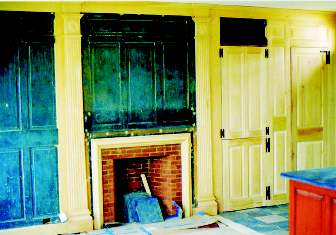 Caroline’s paneled walls are a treat to behold, and are indistinguishable from the antiques she reproduces. She bemoans the fact that they occasionally will be finished with latex paint, which is understandable when you consider that authentic paints are available and only reinforce the historic appearance. A current project on which she is working is for a client in the Pioneer Valley who salvaged some 18th century architectural paneling and carefully stripped off the modern paint, revealing the original Prussian Blue finish. Sly has painstakingly incorporated these pieces into a paneled wall complete with doors, fireplace surround and fluted pilasters.
Caroline’s paneled walls are a treat to behold, and are indistinguishable from the antiques she reproduces. She bemoans the fact that they occasionally will be finished with latex paint, which is understandable when you consider that authentic paints are available and only reinforce the historic appearance. A current project on which she is working is for a client in the Pioneer Valley who salvaged some 18th century architectural paneling and carefully stripped off the modern paint, revealing the original Prussian Blue finish. Sly has painstakingly incorporated these pieces into a paneled wall complete with doors, fireplace surround and fluted pilasters.
Sly’s corner cabinets are also a popular selection, often incorporated into the paneled wall, or furnished as stand-alone pieces of furniture, and range from simple, restrained pieces to rather ornate forms adorned with deeply carved shells at their pediments.
Caroline also builds violins and violas, and working on them is a treat for her. “In the morning, I like to spend time on the instruments before settling down to the architectural woodwork; it’s creative and I enjoy the precise detail work involved.”
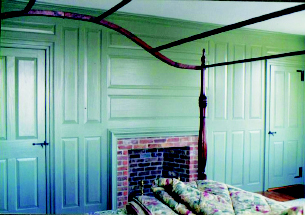 A staunch preservationist, Sly pleads the case for 18th century buildings to those contemplating purchasing them simply for their location or superficial appearance. She states to these prospective buyers, “please, please don’t bulldoze them; do your utmost to find someone who will move it and preserve it. They don’t make them that age anymore! Don’t try and make it something that it is not; if you want a new house, build one!”
A staunch preservationist, Sly pleads the case for 18th century buildings to those contemplating purchasing them simply for their location or superficial appearance. She states to these prospective buyers, “please, please don’t bulldoze them; do your utmost to find someone who will move it and preserve it. They don’t make them that age anymore! Don’t try and make it something that it is not; if you want a new house, build one!”
http://www.carolinesly.com
P O Box 313 in Ashfield, Masssachusetts 01330, email: csly@carolinesly.com or you can telephone her at 413-628-0130



